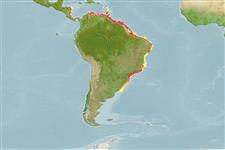>
Carangiformes (Jacks) >
Carangidae (Jacks and pompanos) > Scomberoidinae
Etymology: Oligoplites: Greek, oligos = small + Greek, hoplites = armed (Ref. 45335).
More on author: Bloch.
Environment: milieu / climate zone / depth range / distribution range
Ökologie
seewasser; brackwasser benthopelagisch; tiefenbereich ? - 40 m (Ref. 9626). Tropical; 16°N - 35°S, 89°W - 34°W
Western Atlantic: Laguna de Caratasca, Honduras to Montevideo, Uruguay.
Size / Gewicht / Alter
Maturity: Lm ? range ? - ? cm
Max length : 50.0 cm TL Männchen/unbestimmt; (Ref. 5217); common length : 35.0 cm TL Männchen/unbestimmt; (Ref. 5217); max. veröff. Gewicht: 900.00 g (Ref. 3277)
Adults are found over soft bottoms of the continental shelf, often inshore and in estuaries. Also pelagic and encountered throughout the water column (Ref. 9626). May feed on plankton by ram-filtering. Juveniles feed mainly on planktonic crustaceans and chaetognaths, to a minor extent on benthic crustaceans and polychaetes, besides scales taken from larger fishes (Ref. 30206, 40402). Mature females generally spawn in summer. Eggs are pelagic (Ref. 35237). Marketed mostly fresh.
Life cycle and mating behavior
Geschlechtsreife | Fortpflanzung | Ablaichen | Eier | Fecundity | Larven
Cervigón, F., 1993. Los peces marinos de Venezuela. Volume 2. Fundación Científica Los Roques, Caracas,Venezuela. 497 p. (Ref. 9626)
IUCN Rote Liste Status (Ref. 130435: Version 2024-1)
Bedrohung für Menschen
Harmless
Nutzung durch Menschen
Fischereien: weniger kommerziell; Aquarium: Kommerziell
Tools
Zusatzinformationen
Download XML
Internet Quellen
Estimates based on models
Preferred temperature (Ref.
123201): 22.5 - 28.1, mean 27.3 °C (based on 168 cells).
Phylogenetic diversity index (Ref.
82804): PD
50 = 0.5312 [Uniqueness, from 0.5 = low to 2.0 = high].
Bayesian length-weight: a=0.00741 (0.00470 - 0.01169), b=2.94 (2.81 - 3.07), in cm total length, based on LWR estimates for this species & Genus-body shape (Ref.
93245).
Trophic level (Ref.
69278): 3.8 ±0.62 se; based on food items.
Widerstandsfähigkeit (Ref.
120179): mittel, Verdopplung der Population dauert 1,4 - 4,4 Jahre. (Preliminary K or Fecundity.).
Fishing Vulnerability (Ref.
59153): Moderate vulnerability (40 of 100).
Nutrients (Ref.
124155): Calcium = 105 [71, 257] mg/100g; Iron = 1.22 [0.74, 2.31] mg/100g; Protein = 18.5 [17.4, 19.7] %; Omega3 = 0.244 [0.129, 0.468] g/100g; Selenium = 50.3 [27.3, 96.0] μg/100g; VitaminA = 34.7 [10.7, 88.7] μg/100g; Zinc = 1.2 [0.9, 1.7] mg/100g (wet weight);
